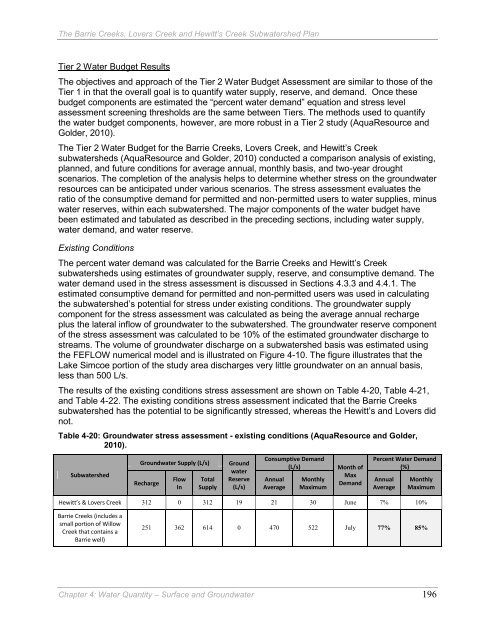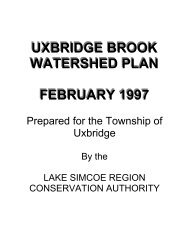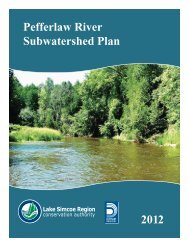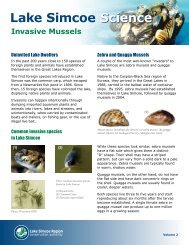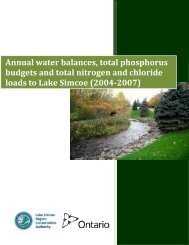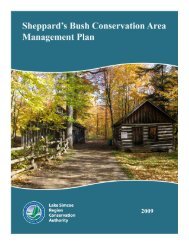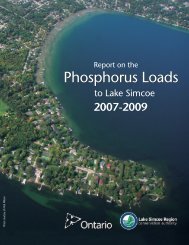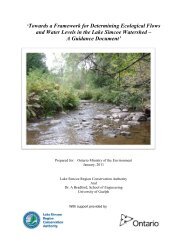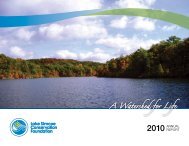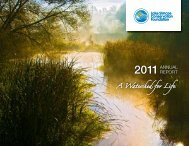Barrie Creeks, Lovers Creek, and Hewitt's Creek Subwatershed Plan
Barrie Creeks, Lovers Creek, and Hewitt's Creek Subwatershed Plan
Barrie Creeks, Lovers Creek, and Hewitt's Creek Subwatershed Plan
You also want an ePaper? Increase the reach of your titles
YUMPU automatically turns print PDFs into web optimized ePapers that Google loves.
The <strong>Barrie</strong> <strong><strong>Creek</strong>s</strong>, <strong>Lovers</strong> <strong>Creek</strong> <strong>and</strong> Hewitt’s <strong>Creek</strong> <strong>Subwatershed</strong> <strong>Plan</strong><br />
Tier 2 Water Budget Results<br />
The objectives <strong>and</strong> approach of the Tier 2 Water Budget Assessment are similar to those of the<br />
Tier 1 in that the overall goal is to quantify water supply, reserve, <strong>and</strong> dem<strong>and</strong>. Once these<br />
budget components are estimated the “percent water dem<strong>and</strong>” equation <strong>and</strong> stress level<br />
assessment screening thresholds are the same between Tiers. The methods used to quantify<br />
the water budget components, however, are more robust in a Tier 2 study (AquaResource <strong>and</strong><br />
Golder, 2010).<br />
The Tier 2 Water Budget for the <strong>Barrie</strong> <strong><strong>Creek</strong>s</strong>, <strong>Lovers</strong> <strong>Creek</strong>, <strong>and</strong> Hewitt’s <strong>Creek</strong><br />
subwatersheds (AquaResource <strong>and</strong> Golder, 2010) conducted a comparison analysis of existing,<br />
planned, <strong>and</strong> future conditions for average annual, monthly basis, <strong>and</strong> two-year drought<br />
scenarios. The completion of the analysis helps to determine whether stress on the groundwater<br />
resources can be anticipated under various scenarios. The stress assessment evaluates the<br />
ratio of the consumptive dem<strong>and</strong> for permitted <strong>and</strong> non-permitted users to water supplies, minus<br />
water reserves, within each subwatershed. The major components of the water budget have<br />
been estimated <strong>and</strong> tabulated as described in the preceding sections, including water supply,<br />
water dem<strong>and</strong>, <strong>and</strong> water reserve.<br />
Existing Conditions<br />
The percent water dem<strong>and</strong> was calculated for the <strong>Barrie</strong> <strong><strong>Creek</strong>s</strong> <strong>and</strong> Hewitt’s <strong>Creek</strong><br />
subwatersheds using estimates of groundwater supply, reserve, <strong>and</strong> consumptive dem<strong>and</strong>. The<br />
water dem<strong>and</strong> used in the stress assessment is discussed in Sections 4.3.3 <strong>and</strong> 4.4.1. The<br />
estimated consumptive dem<strong>and</strong> for permitted <strong>and</strong> non-permitted users was used in calculating<br />
the subwatershed’s potential for stress under existing conditions. The groundwater supply<br />
component for the stress assessment was calculated as being the average annual recharge<br />
plus the lateral inflow of groundwater to the subwatershed. The groundwater reserve component<br />
of the stress assessment was calculated to be 10% of the estimated groundwater discharge to<br />
streams. The volume of groundwater discharge on a subwatershed basis was estimated using<br />
the FEFLOW numerical model <strong>and</strong> is illustrated on Figure 4-10. The figure illustrates that the<br />
Lake Simcoe portion of the study area discharges very little groundwater on an annual basis,<br />
less than 500 L/s.<br />
The results of the existing conditions stress assessment are shown on Table 4-20, Table 4-21,<br />
<strong>and</strong> Table 4-22. The existing conditions stress assessment indicated that the <strong>Barrie</strong> <strong><strong>Creek</strong>s</strong><br />
subwatershed has the potential to be significantly stressed, whereas the Hewitt’s <strong>and</strong> <strong>Lovers</strong> did<br />
not.<br />
Table 4-20: Groundwater stress assessment - existing conditions (AquaResource <strong>and</strong> Golder,<br />
2010).<br />
<strong>Subwatershed</strong><br />
Groundwater Supply (L/s)<br />
Recharge<br />
Flow<br />
In<br />
Total<br />
Supply<br />
Ground<br />
water<br />
Reserve<br />
(L/s)<br />
Consumptive Dem<strong>and</strong><br />
(L/s)<br />
Annual<br />
Average<br />
Monthly<br />
Maximum<br />
Month of<br />
Max<br />
Dem<strong>and</strong><br />
Percent Water Dem<strong>and</strong><br />
(%)<br />
Annual<br />
Average<br />
Monthly<br />
Maximum<br />
Hewitt’s & <strong>Lovers</strong> <strong>Creek</strong> 312 0 312 19 21 30 June 7% 10%<br />
<strong>Barrie</strong> <strong><strong>Creek</strong>s</strong> (includes a<br />
small portion of Willow<br />
<strong>Creek</strong> that contains a<br />
<strong>Barrie</strong> well)<br />
251 362 614 0 470 522 July 77% 85%<br />
Chapter 4: Water Quantity – Surface <strong>and</strong> Groundwater 196


